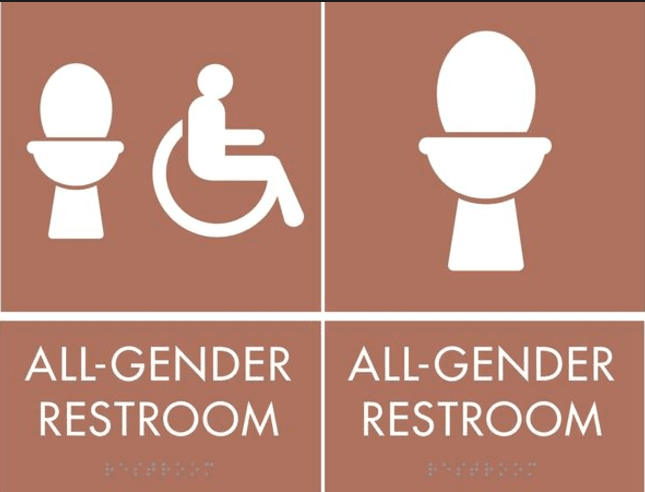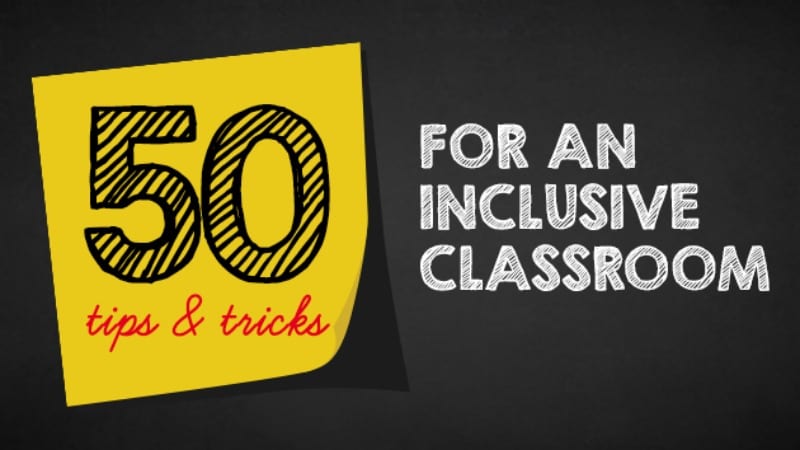Most of us know that creating a more inclusive learning environment is a good thing. But figuring out what steps to take to benefit our marginalized students without singling them out as being different is a challenge. That’s why we put together a few ideas to help you facilitate a more inclusive classroom.
1. Incorporate less commonly heard points of view in lessons.
Too often marginalized voices go unheard and discounted, especially in schools. Offer your students a wider view of the world (and maybe even some role models that share their experience) by incorporating magazine articles, books, and speeches by people who aren’t white, cisgender, straight men.
2. Go deeper on “heritage days”.
It’s great to celebrate other cultures, but make sure you’re not reducing them to stereotypes. Instead, introduce books by authors of your target culture. Bring in guest speakers who can speak to their own experiences, rather than trying to do it all yourself.
3. Educate kids on why their language matters.
No matter what age you’re teaching, kids often don’t understand the power of words. Help them understand that what they say can have a profound effect on others—for better or for worse.

4. Don’t ignore when students use harmful language—even when they’re not using slurs.
Every few years there’s a new popular phrase that minimizes the real experience of others and causes harm, even if it’s not widely seen as a slur. When I was in high school that phrase was “that’s gay,” but now it seems to be “I’m triggered.” When you hear students throwing this around, interrupt their behavior and take advantage of the teachable moment. Let them know that there’s a good chance someone they care about has trauma in their background.
5. Use Comic Sans, Ariel, or Dyslexie for your handouts.
A simple change you can make in your classroom is to use a different font—several are easier for students with different types of disabilities like dyslexia to read.
6. Make sure your field trips are accessible.
You may not have students with visible disabilities like wheelchairs in your class, but you may still have someone with a bad knee or a phobia who just isn’t going to be able to do that vertical cave trip with 426 stairs you have planned. Take a few steps at the beginning of the school year to find out if the field trips you have in mind will work for the students you have. And if they won’t, look for another way to accommodate them.
7. Keep some “toys”—even fidget spinners—available.
Everybody hates fidget spinners right now, but devices like them help students who struggle to pay attention in class focus more easily. Keeping a few around could make a big difference in your overall classroom behavior—but don’t be afraid to set boundaries if students are abusing them!

8. Don’t police gender.
Just don’t do it. If one of your male students wants to play with dolls, let them. If you have a female student named Charlie don’t point out that it’s a name for boys. Your students aren’t hurting anyone and are well on their way to creating a more inclusive world by ignoring gender rolls and rules.
9. Use restorative justice.
We’ve all been there. A student seems bent on creating problems in your classroom so you snap and kick them out instead of taking the time to get at what might be underlying the issues and finding a long-term solution. That student may have an undiagnosed learning disability or severe problems at home. Spend a little bit of extra time figuring out what’s driving the behavior in the first place. Then figure out how to turn the consequences into an age-appropriate teachable moment. Click here for classroom resources.
10. Keep consequences consistent.
As important as it is to find out what’s underlying students’ poor classroom behavior, it’s equally important to ensure that students know exactly what’s going to happen if they do X. Often students with behavioral issues have unpredictable home environments. A predictable classroom may be their only safe haven. Keep the rules and consequences consistent, even when you’d rather do the kid a favor and let them off easy, and you’ll begin building trust.
11. Offer your notes or PowerPoints to students.
Students who struggle with hearing issues can benefit from having a written reference available to them so that they don’t miss out on critical details.

12. Interrupt when students police or shame each other.
Students often say things that aren’t nice to each other. Instead of ignoring it when students make fun of each other for smelling funny or dressing different, let them know that behavior isn’t okay and be sure to follow through if it persists.
13. Avoid using students differences for “teachable moments”.
I’m a firm believer in providing students with the “why” whenever possible, but when a student is teasing another for dressing in ill-fitting or hand-me-down clothes it’s not appropriate to point out that the student they’re teasing may be low-income. Simply letting students know that the behavior is inappropriate and won’t be tolerated is sufficient.
14. Offer a wider variety of options in your classroom library.
The books in your library may be the only things that expose your students to different ideas and people. Be sure to include books by diverse authors and that feature characters from a range of backgrounds.

15. Avoid using language like “mom or dad” in reference to your students’ households.
You don’t always know who your students might be going home to. Assuming everyone lives with a mom or a dad or a mom and dad can be really alienating for kids in foster care, living with other relatives, or who come from LGBTQ households.
16. Support students in creating affinity spaces.
Sometimes marginalized students need a place to get away from people who don’t share their experiences. Help your students start a Black Student Union or a Queer Center on campus.
17. Support students in creating pride organizations.
Create spaces for members of marginalized communities and their allies to take on social change in their communities, at their school, or even just to show support for one another. For students who are looking to celebrate their Native heritage or disability status in this way, offer your classroom or guidance in making it happen.
18. Work with your principal to change school culture.
Often the students are way ahead of the rest of us in creating inclusive cultures on campus, so working with high level administrators to change the tone from the top down can make a big difference in bringing the whole campus on board.

19. Use your professional development days to gain more diversity and inclusion training.
There are a lot of great conferences that address issues around creating more inclusive communities, whether they focus on rape culture or explicitly on creating more inclusive education, consider using some of your time to learn more about how to better support your students.
20. Teach the material in a variety of ways—play to your kids’ strengths.
Every teacher knows not all students learn the same way. Introduce students to material in a variety of ways to help improve learning outcomes and make sure every student has the best possible chance of understanding the material.
21. Allow your students to develop their own milestone projects.
Major projects are a great way to give students something to be proud of and to synthesize what they’ve learned. But often teachers elect to assign identical projects to each student, rather than letting students take ownership and develop a project that plays to their strengths. Some students may fare better with a paper than a poster and still others may need to build something to truly grasp the information. Plus you don’t have to read the same five pages 30 times over.
22. Let marginalized students have the floor—but don’t force it on them.
You’ve seen it happen. You bring up black activists during one of your lessons and every head turns to the lone black student in your class. Don’t be one of them. If that student wishes to share, by all means let them speak. But if they look like they’d rather be invisible, draw your students’ attention back to the material.

23. Genuinely care about and consider other factors in your students’ lives.
Your students come from a wide range of situations. It’s important to consider how their experiences might be affecting their classroom performance and plan accordingly. For example, if most of your students access internet at the library rather than at home, consider giving more class time for internet-based research.
24. Plan activities for your students to share more about themselves—but don’t put them on the spot!
Sometimes your best resource for gaining new insights can be your marginalized students. Invite them to show off their lives during “heritage days” or lessons about disabilities if they are comfortable doing so.
25. Give space for preferred pronouns, but avoid requiring students to share.
Asking every student to share their preferred pronoun at the beginning of the semester can force a closeted student to either out themselves or misgender themselves. Neither is what you were going for. Instead, offer your pronouns as an invitation for other to share theirs, but don’t demand it if someone refrains.
26. Keep in mind where a student is coming from when addressing issues.
It’s crucial to remember that when a student isn’t turning homework in on time, it likely doesn’t mean the student is lazy or disorganized. It could mean the student needs accommodations for a disability or is taking in a lot of household responsibility that doesn’t give adequate time to do schoolwork.
27. Plan activities for your students to think about and show appreciation for each other.
Have students share what they like and admire about each other a few times a year to build a more positive community.

28. Work with your administration to create a more inclusive dress code.
We hear about it every spring. Students (usually girls) get turned away from prom or kicked out of class for wearing clothes deemed “distracting” to others. This unfairly puts the responsibility for other students’ focus (or lack thereof) on individual students’ wardrobe choices. Instead, insist that the faculty identify what the ultimate goals in creating a dress code are, and go from there.
29. If you’re teaching about religions, spend equal time on each that you cover.
If your school is anything like the one I grew up in, most of your students probably identify as Christian. It can be tempting to use that as a basis for examining all religions. However, if you spend a lot of time on one faith and not a lot of time on others, the one you focus on could seem more legitimate or “better” to students.
30. Learn as much as you can about what students from different backgrounds might be experiencing at home.
You may be the most well-intentioned teacher out there, but if you don’t back it up by doing your own homework and reading widely, you’re going to have a hard time understanding where your students may be coming from.
31. Refrain from having class-wide celebrations that involve food during times students may not be able to partake.
If you’ve got Muslim students in your class and you hold a food-based celebration during Ramadan, chances are that student is going to feel excluded from the festivities. Check the calendar to make sure your classroom celebration doesn’t conflict with religious celebrations that include fasting.

32. Be aware of any food allergies before planning a food-related event.
Ask students and/or parents if there are any dietary restrictions.Make sure any food served to the class adheres or that large pot-luck style events include options for everyone.
33. Offer snacks for students who may be missing meals.
The free and reduced lunch program makes a huge difference for millions of kids living with food insecurity. Unfortunately, the program doesn’t cover missing meals or the fact that lunch is the only meal these students get. Keeping your classroom armed with some affordable healthy snacks could make a huge different in your students’ nutrition.
34. Keep handouts for local social services readily available.
Sometimes your students will be going through things they’d rather not share. Ideally their parents will know what’s going on and how to navigate support, but often that’s not the case. Have a few handouts pointing them in the right direction. Place them somewhere visible so students can grab them without drawing attention to themselves.
35. Avoid segregating students by gender.
Again you may have closeted or non-binary students in your classroom who could feel alienated by being asked to identify in this way. Instead consider assigning students numbers or dividing into groups based on shirt color instead.

36. Use gender neutral language.
Avoid phrases like “ladies and gentlemen” and encourage classroom guests to do the same. Refraining from using binary language your classroom is really affirming to non-binary learners and avoids erasing their experiences.
37. Celebrate your students’ diversity, but please don’t tokenize.
It can be tempting to ask a student of color to share a favorite dish from the place of their heritage, but not all students are so keen to share. Whatever their reasoning, it’s okay for students not to want to be labeled “the _____ kid.” Make sure you’re celebrating them as multi-dimensional members of your community and doing it on their terms.
38. If possible, offer important documents in your students’ and parents’ primary languages.
Not all students or parents speak English fluently. Sometimes it’s more important that the information is received than language skills are practiced. When this happens, providing the information in students’ and parents’ primary language can avoid misunderstandings.
39. Think of IEPs and other support plans as opportunities to do better by your students—not as impositions on your time.
Sometimes it can feel overwhelming to be asked to accommodate several different students’ needs all at once. Instead of letting it get to you and allowing you to resent your students, make sure you’re thinking of IEPs as an effective communication tool that help you be better at your job.
40. Help students identify their own learning outcomes—and support them in meeting them.
We all have our goals for our students, but sometimes what we had in mind and where the students really are are two very different matters. Work with your students early and often to adjust their own goals and give them ownership over learning.
41. Take time to appreciate student accomplishments regularly.
Especially when you have students who are frequently disruptive in class, it can be difficult to see the positive attributes that student brings with them every day. Take time regularly to acknowledge the skills and positive attributes of every student- not just the ones that are easy to work with.
42. Work with administrators to establish gender neutral bathrooms around campus.
For students who are trans or non-binary, going to the bathroom can be confusing or downright dangerous. Having bathrooms in convenient places around campus where any student can go free from harassment is vital to keeping all students healthy.

43. Spend more attention with feminine-presenting students in math and science.
Studies show that when teachers are spending what they perceive to be an inordinate amount of time with femme students in science and math classes they barely break even. So don’t be afraid to tip the scales and try this experiment out yourself. You might be surprised.
44. Avoid even positive stereotypes of different groups.
Just as believing your students are less able to do something can harm them, believing your students are naturally more capable than they really are can lead to spending disproportionately less time with them. Be sure you’re not letting the “model minority” stereotype impede your ability to help all your students succeed.
45. Learn how to say your students’ names.
Spend some time after you get your class list checking pronunciations on YouTube. Be sure to ask every student how to say their name- even if you’re pretty sure you know. Asking every student avoids drawing attention to students with more challenging names and gives you a chance to be sure you’re right. You never know when a student with a conventional spelling will have an unconventional pronunciation.
46. Use content warnings.
Content warnings let your students know that you respect them as people and gives them a chance to prepare emotionally if some of the material you’ll be covering might hit a little too close to home.
47. Make E-readers available.
There are some free e-readers available on the internet that can make a big difference to students who may benefit from audio learning or who struggle with reading due to poor eyesight, a disability, or interrupted education.

48. See if your school can spring for audiobooks.
Again, giving students the option to listen rather than read can significantly improve retention and may drastically improve outcomes for students with some disabilities.
49. Make space for differently abled students.
If you regularly employ movement breaks into your day, be sensitive to students who may need adaptations or individualized activities. Or better yet, choose activities that won’t single them out.
50. Supplement your curriculum.
Make sure your curriculum doesn’t center around a European male point of view. Be sure to include content about and by people with different perspectives.


